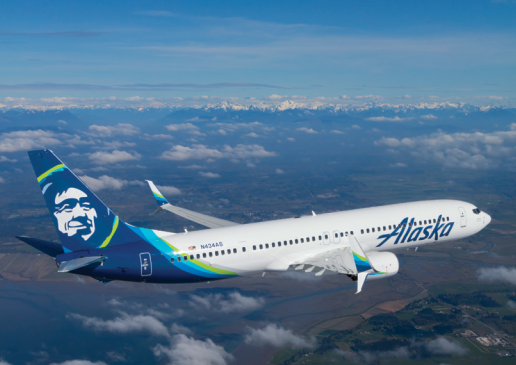Articles
| Name | Author | |
|---|---|---|
| Case Study: Lufthansa fuel saving | Tom Duddeck, Manager Fuel Efficiency, Lufthansa German Airlines | View article |
| Case Study: ETL: The move from paper — Part 2 | Rob Woods, Head of Engineering, Air Arabia Maroc, Dave Cooper, Line Maintenance Manager, British Airways Cityflyer, and Cameron Hood, CEO, NVable | View article |
| Case Study: Icelandair Fuel Savings | Einar Ingvi Andrésson, Manager, Fuel Efficiency, Icelandair | View article |
| Qatar Airways Live Flight Tracking | Stephen P. Carroll, Flight Operations Project Manager, Qatar Airways | View article |
| Case Study: Lifting the load | Brian Watson, Manager Weight and Balance, Alaska Airlines | View article |
| Column: The World according to IT and me.. So… Apparently something happened in June | Paul Saunders, Solution Manager, Flatirons Solutions | View article |
Case Study: Lifting the load
Author: Brian Watson, Manager Weight and Balance, Alaska Airlines
SubscribeTaking the load

Alaska Airlines’ and Horizon’s new Weight & Balance system, explains Brian Watson, Manager Weight and Balance, at Alaska Airlines, improves the loading process and much more
MOTIVATION FOR CHANGES
Prior to the project that is the subject of this case study Alaska Airlines was using a legacy weight and balance system that had been built in-house. While it had served the airline well, it was an aging system that was difficult to maintain and couldn’t be easily changed to support evolving business demands. The system was heavily reliant on manual data entry from other systems, and lacked functionality to support standardization of processes.
The primary motivations for change were to implement a system that supported standardization, automation, and scalability. Standardizing processes not only ensures common understanding between workgroups but it also produces consistent and repeatable results that drive performance. The ability to automate much of the load planning and reconciliation process allows load agents to concentrate on more complex problem-solving. A scalable solution allows the system and processes to grow and evolve with the changing business environment.
PROJECT SUMMARY
Alaska and its sister airline, Horizon, achieved a major step toward automating much of the load planning process when, with the help of the SmartLOAD system, the airlines were able to standardize processes, reduce rework, and increase communication among workgroups. While there were some process changes, the flexibility of SmartLOAD allowed for highly configurable business rules to support existing processes.
THE PROJECT
As the original launch customers of SmartLOAD, Alaska and Horizon partnered closely with Smart4Aviation to define the requirements of the system. A big part of that work was documenting the processes and business rules that had been in place for decades. While challenging, converting this organizational knowledge into well-documented processes and business rules was crucial. It played an integral role in helping to understand which parts of the load planning process could be automated, and which parts would be better monitored by load planners.
Throughout the development stage of the project, the system was delivered in iterations. A dedicated group of test engineers and business subject matter experts conducted testing and review of each iteration. A mix of test data management tools were used to setup testing and training environments with virtualized data. This approach was very beneficial since it provided a set of consistent data, while also allowing for the creation of irregular scenarios on demand.
Another major piece of the project was readying load planners, airport staff, and other impacted workgroups for the shift from manual to automated processes. A people change management plan was created to provide a blueprint for how to best communicate with each workgroup, and navigate them through the change. This is one area of major projects that is often underestimated. The success of the project relied heavily on each workgroup understanding the change, the benefits, and how the change would impact them.
As we prepared to deploy the system, using virtualized data in our training environment allowed us to deliver a real-world training experience that extended well beyond the classroom. Not only did users get to touch and feel the system, but they also got to work with data that was familiar to them. It allowed for tailored data to simulate specific scenarios, instead of having to wait for them to occur naturally. While this hands-on system training was very beneficial, actual boots on the ground support for load planners and airport staff was also a critical component. Onsite support staff were able to answer system questions quickly and also served as great resources to reinforce changes to business processes.

THE CHALLENGES
The biggest challenge of the project was its sheer size and complexity. Implementing a new system on its own is a challenge, but redefining processes greatly increases planning and resource needs. Identifying the right mix of subject matter experts from all impacted workgroups and IT was crucial. It was critical to find the right people that were experts on existing processes and had the vision to imagine new automated processes.
Weight and balance may seem simple enough, but it touches almost every operational workgroup, and is nearly the last step before the aircraft departs the gate. Much consideration and forethought was required to determine how SmartLOAD’s load planning automation would change processes for workgroups. A big challenge was transforming manual data handoffs between workgroups into new automated steps that would be handled by the system. As automation increased, weak spots in existing processes became readily apparent. This was a great opportunity to identify problem areas, and continually work to improve processes and system controls.
Identifying and building all of the interfaces between external systems and SmartLOAD was also a significant undertaking. Beyond the actual development work, there was a considerable amount of effort spent on defining the interface specifications. Questions had to be answered about what data should be included in the interface, when should data be returned, and when data shouldn’t be returned. Additionally, an understanding of how a user would request data and pass it on manually had to be transformed into automated system interfaces. Even more challenging was writing logic into interfaces to protect against unexpected data when users were not following processes or business rules.
Early on, the need for both event and time-based system interfaces was discovered. In order to deliver data to SmartLOAD at specific times, a mechanism had to be developed to request this data. Through partnership with Smart4Aviation, a concept of Countdown Alerts was developed within SmartLOAD. These Countdown Alerts are configured to generate at specific times, and are used to request data from external systems. This functionality has become a critical component of the system, and allows each airline to control the timing of data updates within the system.
KEY FEATURES IN THE FINAL SOLUTION
- Automated Load Plan generation, including auto-positioning based on configurable loading preferences;
- Automated Load Closeout generation and uplink to aircraft;
- Real-time system alerting that supports management by exception;
- Integrated peer-to-peer messaging between workgroups;
- 23 inbound and outbound interfaces with other systems including: ops control, passenger, baggage, cargo, ACARS, dispatch, maintenance, crew, mobile ramp and passenger reconciliation, TTY (Teletype Telex Machine), email, and fax;
- Dangerous goods compatibility and MEL (minimum equipment list) checking;
- Supports electronic record keeping and archiving of weight and balance documents.
BENEFITS ACHIEVED
The implementation of SmartLOAD and accompanying process changes has allowed Alaska and Horizon to automate the vast majority of the load planning process. The system has taken over more of the mundane tasks, leaving load agents with more time to focus on complex flights, problem-solving, and decision-making. The most popular feature of the system has been peer-to-peer messaging. It works much like text messaging and supports quick communication between workgroups. The real benefit is that the user doesn’t need to know who in particular is working a flight in order to send a message. Messages can be addressed to various roles that are assigned to a specific flight. This feature has increased the speed and accuracy of communication, while also reducing the number of phone calls between workgroups.
The most tangible benefits have been the productivity improvements made possible by automation. At Horizon Air, load plans and load closeouts are automatically generated by SmartLOAD for the vast majority of flights. Alaska Airlines has had similar results, although complex multi-leg flights have more load agent touch time. Increased standardization of processes and reducing manual data entry has also driven a reduction in the number of loading errors.
It’s no secret a considerable amount of time, resources, and planning is required to undertake a major initiative like implementing a new system. It can be especially challenging when home-grown systems are built around existing business processes. However, the benefits of introducing a vendor supported system shouldn’t be ignored. They can help usher in new ways of thinking, process improvement, and industry best practices.
Contributor’s Details
 Brian Watson Bio
Brian Watson BioBrian has worked for Alaska Air Group since 1998 in various operational roles, starting at Horizon Air where he held various roles including station agent, aircraft routing, dispatch, ops control manager, and project management. In 2013, Brian moved to Alaska Airlines to manage the implementation of a new automated Weight and Balance system. Today, he’s responsible for the strategic vision and oversight of weight and balance systems and processes at Alaska Airlines and Horizon Air.

Alaska Airlines Bio
Alaska Airlines, a subsidiary of Alaska Air Group, together with its regional partners, flies 32 million customers a year to more than 110 cities with an average of 970 daily flights throughout the United States, including Hawaii, Canada, Costa Rica and Mexico. With Alaska’s 17 global airline partners 800 worldwide destinations are served. Alaska Airlines was ranked “Highest in Customer Satisfaction Among Traditional Carriers in North America” by J.D. Power from 2008 to 2016

Smart4Aviation:
Smart4Aviation is a company founded on a passion for aviation and the concept of leveraging technology to develop leading edge solutions for the airline industry. Their goal is 100% customer satisfaction and to be a true business partner. The company aims to deliver seamless solutions which improve efficiency, while also reducing operational costs. Smart4Aviation was selected to provide solutions to, among others, Air Canada, Delta Air Lines, Alaska Airlines, Emirates, Qantas, Air France and easyJet.
Comments (0)
There are currently no comments about this article.

To post a comment, please login or subscribe.